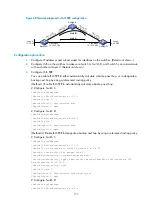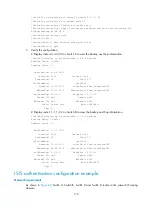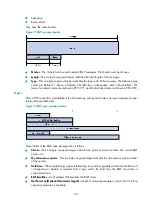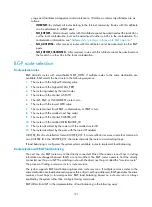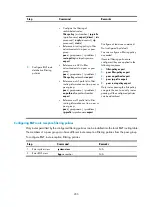
191
usage and facilitates management and maintenance. Well-known community attributes are as
follows:
{
INTERNET
—By default, all routes belong to the Internet community. Routes with this attribute
can be advertised to all BGP peers.
{
NO_EXPORT
—After received, routes with this attribute cannot be advertised out the local AS or
out the local confederation, but can be advertised to other sub-ASs in the confederation. For
confederation information, see "
Settlements for problems in large scale BGP networks
{
NO_ADVERTISE
—After received, routes with this attribute cannot be advertised to other BGP
peers.
{
NO_EXPORT_SUBCONFED
—After received, routes with this attribute cannot be advertised out
the local AS or other ASs in the local confederation.
BGP route selection
Route selection rules
BGP discards routes with unreachable NEXT_HOPs. If multiple routes to the same destination are
available, BGP selects the best route in the following sequence:
1.
The route with the highest Preferred_value
2.
The route with the highest LOCAL_PREF
3.
The route originated by the local router
4.
The route with the shortest AS-PATH
5.
The IGP, EGP, or INCOMPLETE route in turn
6.
The route with the lowest MED value
7.
The route learned from EBGP, confederation, or IBGP in turn
8.
The route with the smallest next hop metric
9.
The route with the shortest CLUSTER_LIST
10.
The route with the smallest ORIGINATOR_ID
11.
The route advertised by the router with the smallest router ID
12.
The route advertised by the peer with the lowest IP address
CLUSTER_IDs of route reflectors form a CLUSTER_LIST. If a route reflector receives a route that contains its
own CLUSTER ID in the CLUSTER_LIST, the router discards the route to avoid routing loops.
If load balancing is configured, the system selects available routes to implement load balancing.
Route selection with BGP load balancing
The next hop of a BGP route may not be directly connected. One of the reasons is next hops in routing
information exchanged between IBGPs are not modified. The BGP router needs to find the directly
connected next hop via IGP. The matching route with the direct next hop is called the "recursive route".
The process of finding a recursive route is route recursion.
The system supports BGP load balancing based on route recursion. If multiple recursive routes to the
same destination are load balanced (suppose three direct next hop addresses), BGP generates the same
number of next hops to forward packets. BGP load balancing based on route recursion is always
enabled by the system rather than configured using commands.
BGP differs from IGP in the implementation of load balancing in the following ways:

